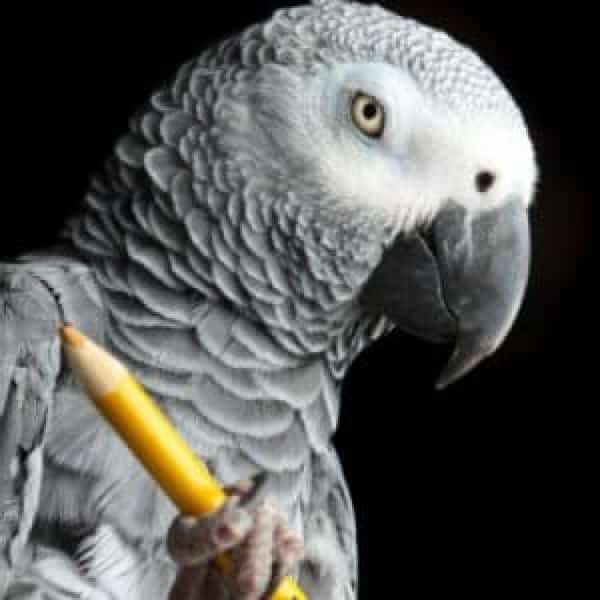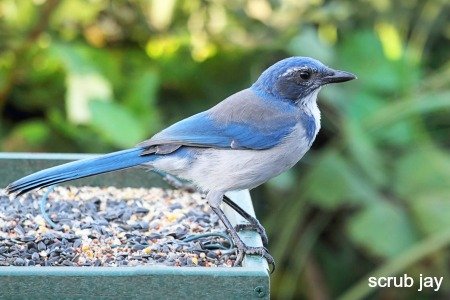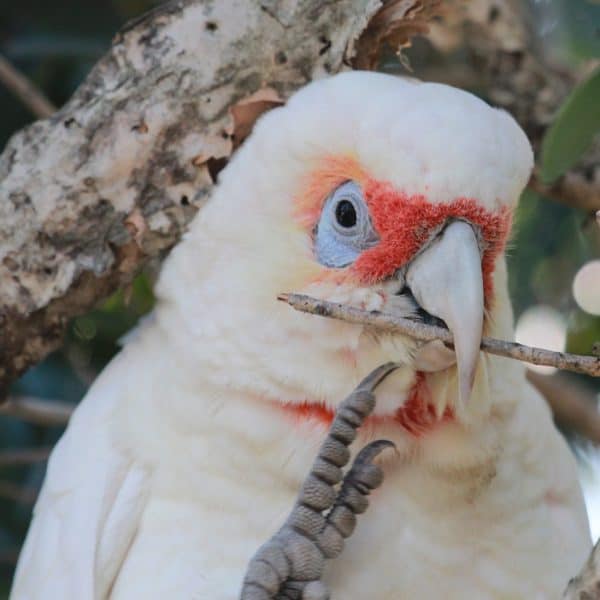
Why How Intelligent Are Birds and Parrots Will Make You Question Everything
Last Updated on by Mitch Rezman
Recently Science magazine ran an article entitled “Parrots, songbirds pack more neurons into their forebrains than most mammals”.
Now some scientists are saying that birds are way more intelligent than we ever thought because they somehow counted the total number of forebrain neurons – with soup (we’ll get to that in a bit)!
The study, published online in the Proceedings of the National Academy of Sciences, found that 28 bird species have more neurons in their pallial telencephalons, the brain region responsible for higher level learning, than mammals with similar-sized brains.
Parrots and songbirds in particular packed in the neurons, with parrots (like the African grey parrot) ranging from 227 million to 3.14 billion, and songbirds—including the notoriously intelligent crow—from 136 million to 2.17 billion. That’s about twice as many neurons as primates with brains of the same mass and four times as many as rodent brains of the same mass.
The count was accomplished using something called brain soup (you can’t make this stuff up) made by dissolving dissected bird brains in a detergent solution. This allowed them to literally count approximately how many neurons occupied a certain region of the brain.
The regions they focused on were portions that allow birds to make tools, plan for the future, learn new songs and mimic human speech.
Surprisingly it was discovered the neurons were much much smaller than expected as well as shorter and tighter connections between the cells. They’re (the scientists) are not sure if these neurons were just small or shrank through evolution in order to keep the birds light enough for flight.
File under correlation does not necessarily imply to causation
Some scientists report that because they know how many neurons belong to different brains they can state more brain equals more cognition. Thus if neurons generate conscious cognition, does having more neurons mean more cognitive capabilities?
It is actually now believed that cognitive capabilities are no longer exclusive to humans but that cognitive differences lie between humans and other animals to a degree. In other words they are not qualitative they are quantitative differences.
We know that chimpanzees and monkeys use tools like twigs and rakes to dig for termites and reach food that is out of sight. Not surprisingly crows can make tools out of wire (shapes) to get food, they put the tools away where they can find them to be used again.
Alex the African grey could produce words that symbolized objects. Birds seem to know what other birds are thinking about like magpies (members of the corvid family) who will bury food with other birds looking and then move it to another location (caching) once the flock has moved on and no other birds are watching – (we’ll talk about this more below).
Magpies seem to actually recognize themselves in a mirror and will use the mirror to self inspect the mark that humans have placed on their heads, below the beak.
Birds have something called the nidopallium, meaning nested pallium. It is the region of the avian brain that is used mostly for some types of executive functions but also for other higher cognitive tasks.
Without getting very technical, we know that the nidopallium governs migration and during migration spatial sensory stimuli actually grows making the birds smarter in real time – something called neuroplasticity
A small bird call the scrub jay, aka blue jay of the west (also a member of the corvid family which includes crows, ravens and magpies) will move its food, usually worms to any number of hiding places. This behavior is called recaching.

Many researchers have assumed this behavior indicates subtle social intelligence. Others like PhD student Elske van der Vaart believe this is simply due to stress.
Personally, I think the scrub jay is pretty slick because if it observes other birds viewing it, as it puts its worms in the ground, it keeps moving them (re-caching) repeatedly like it’s trying to cause confusion in the minds of the other birds (like they are spying).
Once the other birds leave, the scrub jay moves the worms one more time. This behavior appears to indicate that the scrub jay is very special, having abilities that we normally see in humans and maybe some monkeys.
Ms. Van der Vaart and her team feel that this behavior has nothing to do with intelligence but stress. In other words, the scrub jay knows from experience that its own worms are best kept as far away as possible from the rest of the flock.
She goes on to relate that the bird is just stressed about its potential supply of worms and because it moved them so many times it begins to lose track of where the burial places are.
This then stresses the bird out further, all this to bury and move, bury and move – more worms. The caveat here is that this theory was created with a “corvid computer model” that she (Van der Vaart) designed for studying corvid memory and corvid learning behavior.
Personally, I think the birds are pretty smart. Let’s take another look at corvid behavior in Japan from this video
Pigeons have been used by the military for centuries not just for their homing abilities but for their cognitive abilities. We talk about how 1/2 million homing pigeons helped us win World War II but after that, the military experimented with them from search and rescue
experimenting with using them as ballistic missile guides:
In spite of their incredible accuracy versus humans, the military felt that reliance on 50 years of man-made machines and electronics research was superior to 50 million years of avian evolution.
From Wikipedia:
In the 1970s, on the Li River, Pamela Egremont observed fishermen who allowed the birds (cormorants) to eat every eighth fish they caught. Writing in the Biological Journal of the Linnean Society, she reported that, once their quota of seven fish was filled, the birds “stubbornly refused to move again until their neck ring was loosened.
They ignore an order to dive and even resist a rough push or a knock, sitting glum and motionless on their perches.” Meanwhile, other birds that had not filled their quotas continued to catch fish as usual. “One is forced to conclude that these highly intelligent birds can count up to seven,” she wrote.
End Wikipedia:
Many birds illustrate they have the ability to make tools. Woodpecker finches use sticks to impale grubs.
Cockatoos make long objects (tools) to retrieve food from an otherwise unattainable source
A laboratory crow named “Betty” improvised a hooked tool from a wire with no prior experience.
In the video below tens of thousands (millions?) of budgies act as a single organic object to find food using scouting parties to branch off and report back. Small groups exchange information about food sources an quality.
In this video enough starlings to block the sun work in tandem to avoid capture by a single Peregrine falcon.
Hawks flying horizontally through a heavy forest at 60 miles an hour are able to avoid a collision because of their expectation that there is always an “out”.
We can continue with anecdotal and scientific observations but one thing is clear. In that birds have been evolving 100 fold longer than humans, they still have a lot to teach us.
Written by Mitch Rezman
Approved by Catherine Tobsing
Your Zygodactyl Footnote
Author Profile
Latest entries
 The Traveling BirdJune 26, 2025Can You Name 5 Parrot Species That Are Living Wild in the USA?
The Traveling BirdJune 26, 2025Can You Name 5 Parrot Species That Are Living Wild in the USA? Bird BehaviorJune 26, 2025How is it Parrots Are Problem Solvers Social Animals and Even Use Tools?
Bird BehaviorJune 26, 2025How is it Parrots Are Problem Solvers Social Animals and Even Use Tools? Bird & Parrot AnatomyJune 25, 2025How a Tiny Chemical Modification Makes Parrots Nature’s Living Paintings
Bird & Parrot AnatomyJune 25, 2025How a Tiny Chemical Modification Makes Parrots Nature’s Living Paintings PigeonsJune 20, 2025How Do Parrots Thrive in Cities Outside Their Native Habitats?
PigeonsJune 20, 2025How Do Parrots Thrive in Cities Outside Their Native Habitats?
This Post Has 3 Comments
Leave a Reply
You must be logged in to post a comment.



GreyK
12 Jun 2017I annoyed my Timneh yesterday and she stalked me through three rooms, finding objects to drop on my head or fling at me, laughing my laugh.
WindyCityParrot
12 Jun 2017Life with birds:-)